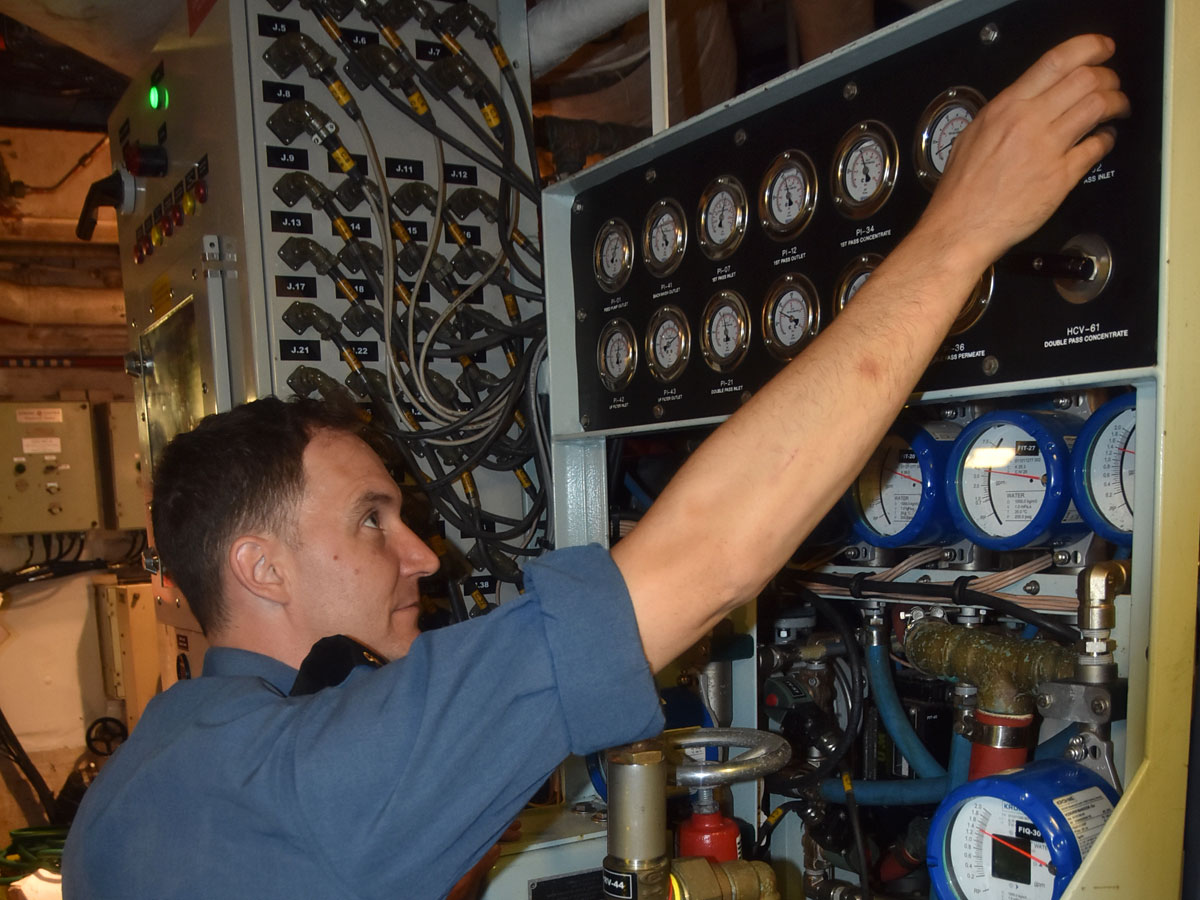Lt(N) Paul LePrieur, HMCS Calgary ~
HMCS Calgary is leading the way on environmental protection.
It became the first ship in the Royal Canadian Navy (RCN) to install an engineering change for use of fresh water as their ballasting medium to achieve compliance with the recently ratified International Maritime Organizations Ballast Water Management Convention.
Fresh water is generated from the ship’s reverse osmosis desalination units and eliminates the threat of transferring aquatic invasive species in the ship’s ballast water.
Ballasting is necessary for ship stability to adjust for varying sea states and loads. Traditionally, this has been accomplished by pumping in sea water directly from the environment. However, this can be a transport mechanism for thousands of species, including hard to detect life such as larva of aquatic animals, or microbes. These non-native species can overrun local ecosystems without the checks and balances of predators, or the natural competition of their original environment.
Many invasive species to Canada have the potential to be carried in ballast water, such as the Zebra Mussel, European Green Crab and Japanese Skeleton Shrimp. Reports indicate these invasions have caused approximately $54 billion in damage worldwide in the last five years alone.
Zebra mussel is a well-known example, having colonized many of North America’s inland water ways, now reaching as far west as California and being detected on recreational craft entering B.C. Zebra mussels completely cover surfaces in newly established waters, suffocating native mussels, clams and plants, altering the food chain, and even the water composition through its filter feeding.
Severe economic impacts occur through the clogging of water intakes and fouling in-water structures and vessels. It has been speculated the first wave of the invasion was started by ballast water released into the Great Lakes in the late 1980s from a vessel originating in the mussel’s native Black Sea habitat.
In 2004, the International Maritime Organizations introduced the Ballast Water Management Convention to address the threat presented by invasive species found in ballast water. Canada has ratified the Ballast Water Management Convention, which recently entered into force, commencing a five-year grace period for ballast water system upgrades for existing vessels.
DND’s environmental policy DAOD 4003 meets or exceeds the spirit of all federal laws, and beyond that, sets its own environmental baselines for ships based on the most stringent standards likely to be encountered during international deployments.
The Director General Maritime Equipment Program Management, in consultation with RCN stakeholders, reviewed the Convention, legislation, policies and ballast water practices to determine the best way to meet the upcoming regulations for existing and future navy vessels. The use of fresh water ballast in the Halifax class was selected as the most effective method to meet the new environmental requirements. The Halifax class is equipped with four ballast water tanks that were originally configured to use untreated saltwater ballast or diesel fuel oil as their ballasting mediums. To maintain the ship’s operational capabilities, the ballast tanks remain available as reserve fuel capacity if required.
In 2017, HMCS Calgary became the first ship to install the new fresh water ballasting system. Calgary was chosen, in part, because it is also one of the first ships, along with HMCS Halifax to upgrade to the latest Mk IV SROD systems for producing fresh water.
Calgary’s first fresh water ballasting operation took place April 10. Using water from the fresh water storage tanks, number one Ballast Tank was filled in one hour. The ballasting operation decreased the Storage Tank level from 90 per cent to 40 per cent and replenishment of the fresh water tanks was completed over an 18-hour period with no water restrictions being placed on the ship’s crew.
The second fresh water ballasting operation took place Aug. 5. This time number two and number three ballast tanks were filled directly from the RODs over a 14-hour period. The fresh water storage tanks were used to provide domestic consumption during this period, again with no water restrictions being placed on the ship’s crew.
Calgary will continue to explore the limitations and capabilities of this new system, and the lessons learned will be used to develop ballasting guidance for the rest of the fleet. While further trials will need to be done to ensure fresh water ballast is achievable under less than ideal conditions, this evolution marks another step in environmental stewardship and signals the navy’s continued commitment to progressive environmental leadership.















